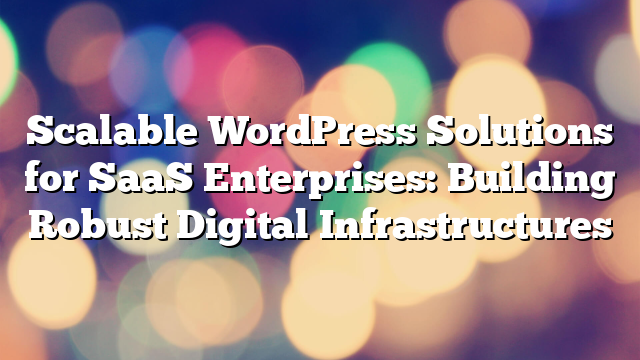Enhancing Enterprise SEO with Headless WordPress
13.12.2024

Search Engine Optimization (SEO) is crucial for enterprises looking to drive organic traffic and establish a strong online presence. While traditional WordPress setups are powerful, Headless WordPress takes enterprise SEO to the next level. By decoupling the front-end and back-end, enterprises can create blazing-fast websites with unparalleled flexibility and control. This article delves into how Headless WordPress enhances SEO for enterprises and helps them stay ahead in competitive markets.
What is Headless WordPress?
Headless WordPress separates the content management system (CMS) from the presentation layer. The back-end is used to manage content, while the front-end is built with modern frameworks like React, Vue.js, or Angular. This architecture communicates via APIs, offering unmatched customization, speed, and performance.
Why Speed Matters for SEO
Website speed is a critical ranking factor for search engines like Google. Faster websites provide better user experiences, leading to lower bounce rates and higher engagement. With Headless WordPress, enterprises can build ultra-fast front-ends that significantly reduce load times. Static site generation (SSG) and server-side rendering (SSR) ensure that pages load quickly, even under high traffic conditions.
How Headless WordPress Improves SEO
1. Faster Load Times
Traditional WordPress sites often suffer from bloated themes and plugins, slowing down load times. Headless WordPress eliminates these issues, enabling lightweight, optimized front-ends that boost performance.
2. Better Mobile Optimization
Mobile-first indexing makes it essential for websites to perform seamlessly on mobile devices. Headless WordPress allows developers to create responsive and mobile-friendly designs that cater to this need, improving rankings.
3. Enhanced Core Web Vitals
Google’s Core Web Vitals—Largest Contentful Paint (LCP), First Input Delay (FID), and Cumulative Layout Shift (CLS)—are crucial for SEO. With Headless WordPress, enterprises can fine-tune their websites to excel in these metrics, ensuring better search engine visibility.
4. Seamless Integration with SEO Tools
Headless WordPress integrates seamlessly with advanced SEO tools and plugins via APIs. Enterprises can leverage tools like Yoast SEO, Rank Math, or custom analytics setups to optimize metadata, monitor performance, and implement schema markup effectively.
5. Structured Data for Rich Snippets
Structured data enhances search engine understanding of website content, leading to rich snippets in search results. Headless WordPress enables precise implementation of structured data through modern frameworks, increasing click-through rates.
6. Superior Content Delivery
With Headless WordPress, enterprises can utilize Content Delivery Networks (CDNs) and edge caching to deliver content quickly to users worldwide. This not only improves speed but also ensures high availability and reliability.
7. Customizable URL Structures
Enterprises can create SEO-friendly, custom URL structures in Headless WordPress. This flexibility ensures clean, descriptive URLs that align with best practices for search engine indexing.
Challenges in Implementing Headless WordPress for SEO
1. Initial Setup Complexity
Switching to a headless architecture requires significant development expertise. Enterprises must ensure their teams are skilled in front-end frameworks and API management.
2. Plugin Compatibility
Many traditional WordPress plugins are designed for monolithic setups and may not work seamlessly in a headless environment. Enterprises must find alternatives or custom solutions to address their specific needs.
3. Maintenance Efforts
A headless setup involves managing separate front-end and back-end systems. This increases maintenance requirements and necessitates clear workflows for updates and troubleshooting.
4. Dependence on Development Teams
Non-technical users may find it challenging to make updates without developer support. Enterprises must invest in user-friendly interfaces or training to empower their teams.
Best Practices for SEO with Headless WordPress
1. Use Server-Side Rendering (SSR)
Leverage SSR to ensure that search engines can crawl your website effectively. This approach renders HTML on the server side, making it accessible to crawlers while maintaining fast load times.
2. Optimize API Calls
Efficient API design is essential for performance. Minimize the number of API requests and ensure that data is delivered quickly to the front-end.
3. Implement Dynamic Rendering
Dynamic rendering provides pre-rendered HTML to crawlers while serving interactive front-ends to users. This ensures SEO compatibility without sacrificing user experience.
4. Focus on Content Quality
While technical optimization is vital, high-quality, relevant content remains the cornerstone of SEO. Use Headless WordPress to create engaging, well-structured content that aligns with user intent.
5. Monitor Performance Regularly
Use tools like Google Search Console, Lighthouse, and PageSpeed Insights to track performance and identify areas for improvement. Regular audits ensure your website stays optimized for search engines.
Conclusion
Headless WordPress is a game-changer for enterprises aiming to enhance their SEO strategy. By combining speed, flexibility, and modern development practices, it empowers businesses to achieve better rankings, higher traffic, and improved user experiences. While the transition to headless may involve challenges, the long-term benefits make it a worthwhile investment.
Ready to revolutionize your enterprise SEO with Headless WordPress? Contact AllWebDev today to explore tailored solutions for your business.



